16+ SAMPLE Trade Agreement
-
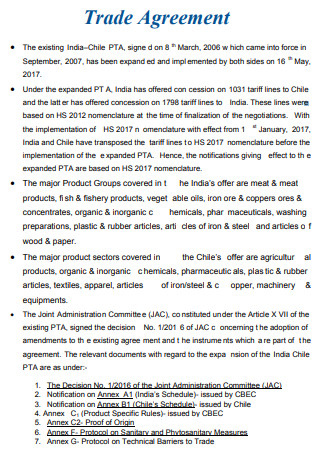
Trade Agreement
download now -
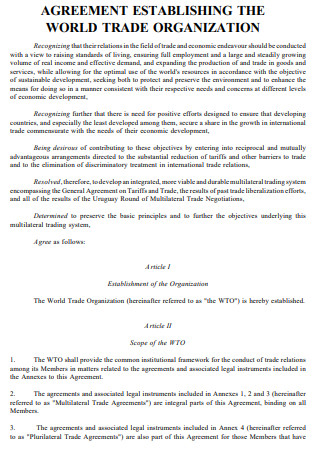
World Trade Organization Agreement
download now -
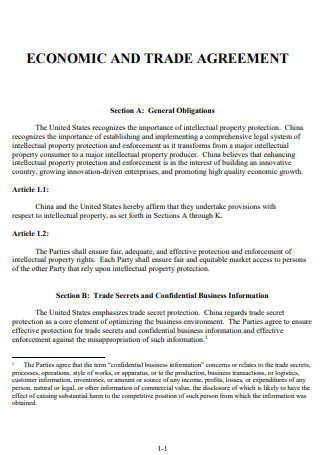
Economic And Trade Agreement
download now -
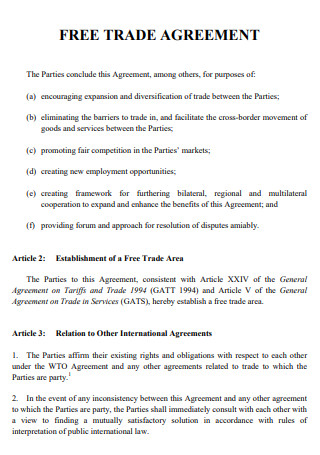
Free Trade Agreement
download now -
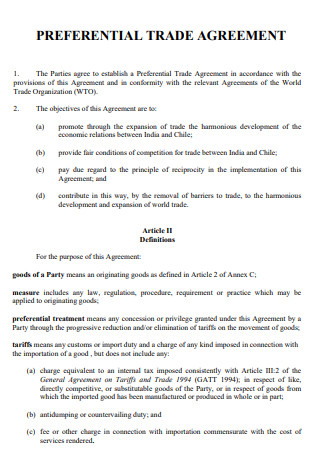
Preferential Trade Agreement
download now -
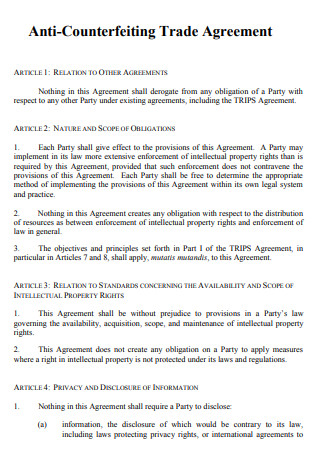
Anti-Counterfeiting Trade Agreement
download now -
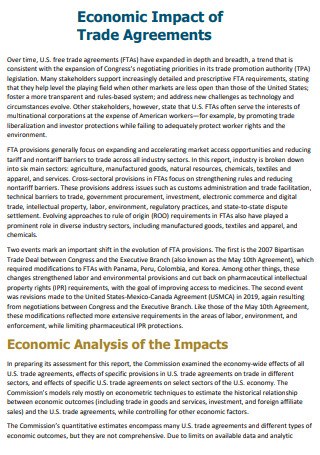
Economic Impact of Trade Agreement
download now -
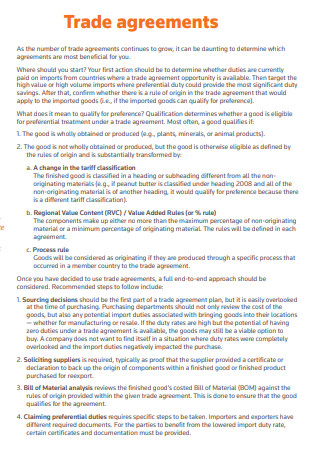
Sample Trade Agreement
download now -
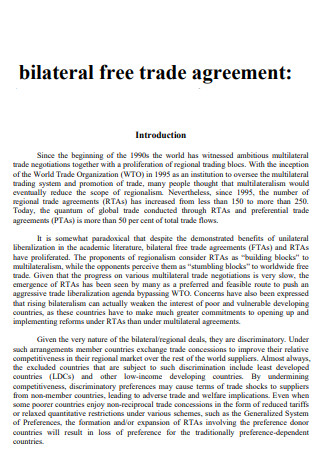
Bilateral Trade Agreement
download now -
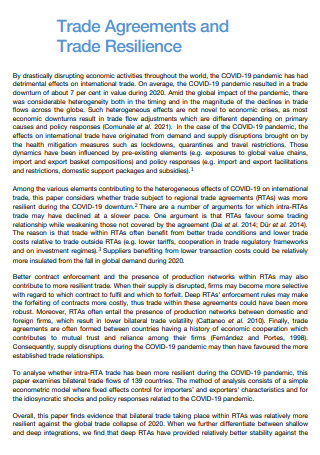
Trade Agreements and Trade Resilience
download now -
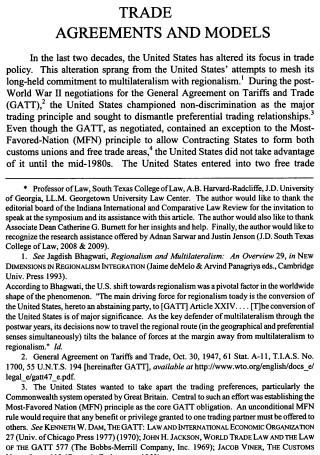
Trade Agreements and Models
download now -
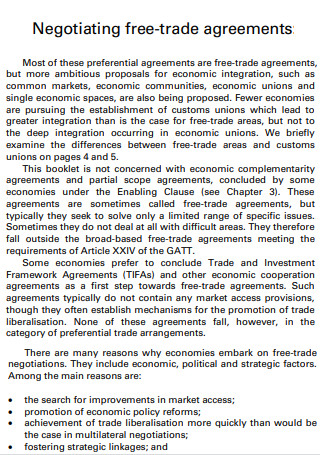
Negotiating Trade Agreement
download now -
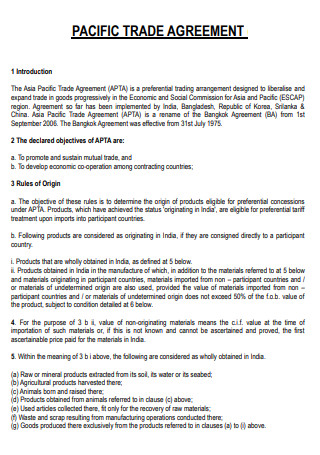
Pacific Trade Agreement
download now -
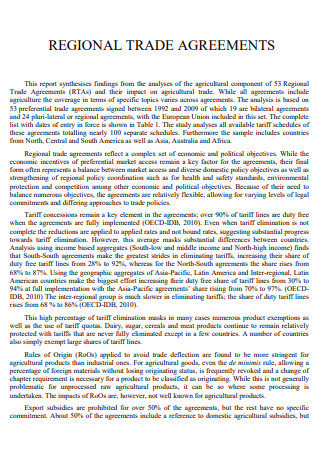
Regional Trade Agreement
download now -
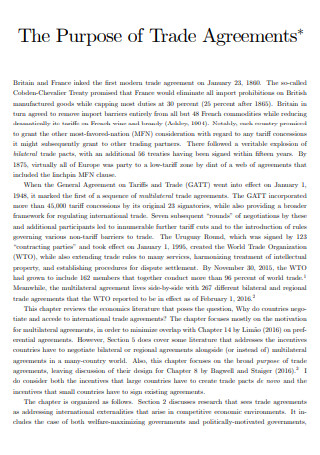
Purpose of Trade Agreement
download now -
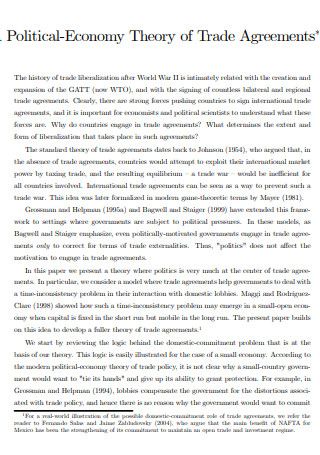
Political Economy Theory of Trade Agreement
download now -
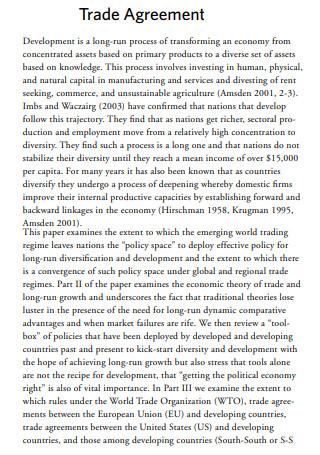
Trade Agreement Example
download now
What Is a Trade Agreement?
A trade agreement is a written and signed document that describes the exchange of products between two or more countries. A trade agreement would aid in the regulation of trade policies such as tariffs, trade barriers, and even government procurement. It strives to develop a balanced deal that will be fair and will provide equal grounds for all participants. A regional trade agreement, for example, would function as a treaty between countries, defining trade regulations for all parties. NAFTA (North American Free Trade Agreement) is an example of an RTA, according to Worldbank.org. The nafta countries are the United States, Mexico, and Canada.
Different Kinds of Trade
In terms of exchange and coverage, there are various types of trade. And trading entails a product cycle from all over the world to a local scene. It is not only beneficial for distribution, but it is also helpful for preserving good relations with neighboring countries. Local trade exists in the form of a farm partnership or a supplier contract. It’s wonderful for eliminating food insecurity and promoting local producers. And there are many other trades that are comparable to these, but with other items and on a different scale. Let’s take a look below to find out.
Benefits of a Trade Agreement
Countries, in general, have trade agreement act in place. These are policies that will be implemented, particularly in external trade. Obviously, trade barriers exist to govern international trade. This is done to safeguard local industry and a country’s economy. International trade that is unregulated may create more harm than good. That is why trade treaties and trade barriers exist. Let’s look at some more of their benefits.
How To Make a Trade Agreement
Trade treaties are critical for multilateral partnerships as well as for a country’s economy. The population is only growing, which has implications. A country has a population to feed, and it should work to feed that population. Trade enters the picture by engaging in trades where profit can be made. Alternatively, where products could be purchased. Trade agreements must be signed and negotiated.
-
Step 1. Trade Participants
There are two or more parties involved in any trade arrangement. The number of participants determines whether a trade is unilateral, bilateral, or multilateral. It would also have an impact on how powerful the trade agreement becomes. It is critical to recognize or list the countries involved in a trade. It is conventional and wields considerable power over the terms of trade agreements. After all, it should be evident that involved countries have signed and agreed to it.
-
Step 2. Goods and Services:
Trade can occur when products and services are exchanged. It makes no difference whether the deal is internal or external. What matters is that their values be compatible. Money is given in return for products. Or a cost reduction in return for another product. A trade agreement pdf must be explicit about the goods and services being negotiated. It may be complex if it is not indicated because goods can be traded from multiple countries.
-
Step 3. Reciprocity
Reciprocity is almost always required in an agreement. Both parties should exchange goods and gain nearly equal advantages. That is why “reciprocity” is a key component of the agreement. It would imply that both parties are expected to profit in the same proportion that they lose. Lowering tariffs on party A’s product, for example, would benefit consumers of party B. At the same time, the producers of Party A would benefit from the same approach. As tax payments decrease, it becomes less expensive for consumers. Increasing the product’s demand proportionally. This part of the trade agreement must be thoroughly negotiated.
-
Step 4. Most-favored-nation Clause
Reciprocity is necessary, but it can also be troublesome. When items are acquired from different nations or producers, the issue of reciprocal concessions arises. In other words, governments could agree to cut tariffs in exchange for something else. That is, a government could continue to cut tariffs in exchange for other concessions. A most-favored-nation clause would assure that all trading partners receive the same existing lowest tariff. It would level the playing field for competing products and producers and not discriminate.
-
Step 5. Other Special Clauses
Different constraints and restrictions are included in trade agreements. Trade agreements could include outright prohibitions or requirements, as well as various selective taxes. This could imply that nontariff barriers should be discussed. Barriers are built to aid in the regulation of the movement of goods. In addition, it must defend its customers. However, if everything is taxed with a tariff, the producers may suffer just as much as the consumers. These special provisions would erect nontariff barriers or make special concessions.
FAQS
Why Is a Trade Agreement Beneficial?
A trade agreement aids in the regulation of trade policies and the flow of goods. It is critical to ensure that all parties involved receive the same benefits or suffer the same losses. Trade can be difficult. It is still possible to be exploited. A trade agreement would not only put things in paper but would also ensure that they are fair. It helps to regulate fraud. It also provides for advantageous bargaining.
What is a Multilateral Trade Agreement?
A multilateral trade deal is one in which three or more countries participate. It is a negotiation aimed at lowering tariffs without favoring any of the countries involved in the agreement. As more countries are involved, this type of arrangement might get increasingly complicated.
What Is a Free Trade?
When it comes to imports and exports, free trade means that there are no restrictions. It is a policy that influences international trade. It may promote commerce in the absence of tariffs or other impediments. That means there is an almost unrestricted trade in goods. It can be an issue since an influx can be harmful to domestic manufacturers. Although it may be advantageous to customers because things will be cheaper.
Trade would mean an equal exchange of goods on an equal footing. It should be regulated, and existing policies should be in place. A trade agreement would solve those problems. But creating one could be pretty difficult. You can, however, make one by obtaining trade agreement templates at Sample.Net!
